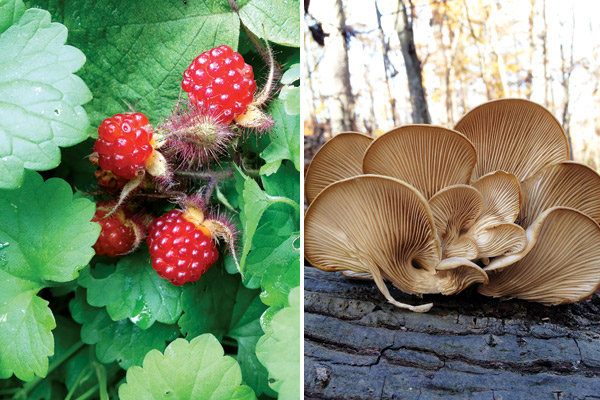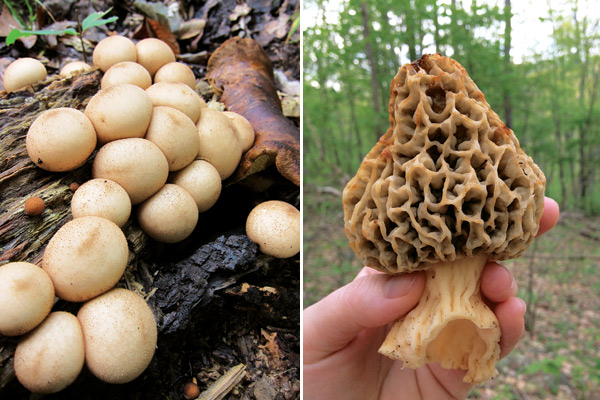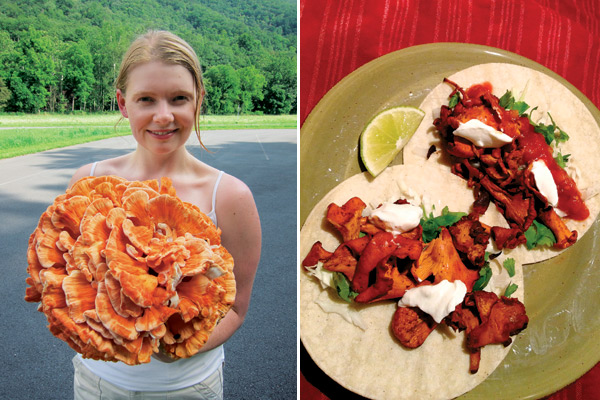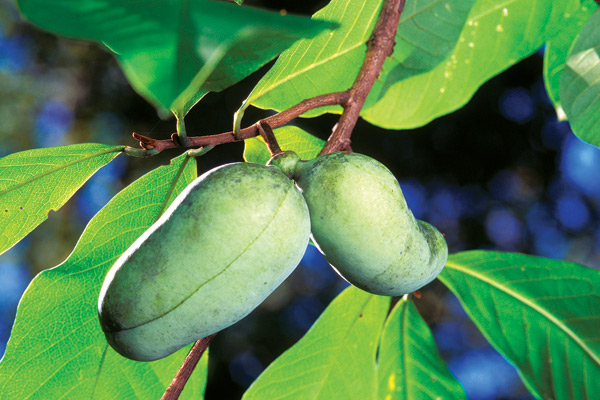WIND RUSHES OFF the ice-crusted Potomac on a blustery February afternoon as Willow Nero makes her way along the dirt trail that encircles Roosevelt Island between Arlington and Georgetown.
As she walks, her eyes scan the forest floor on either side. To the untrained eye, there’s just a brown patchwork of fallen leaves, spots of lingering snow and barren foliage waiting for spring to bloom again. It doesn’t look like the kind of place you’d find much that’s alive, much less to eat.
Soon, however, Nero is pointing toward a half-moon-shaped white fungi clinging to the side of a rotting log. “These might be old oyster mushrooms,” she says, confirming her initial identification on closer inspection. “If we had found them earlier [in the season], we could have eaten them.”
Farther down the trail, she eyes a stand of cattails rising from a stretch of frozen marshland. “You can eat the bit that’s close to the root,” Nero explains. “It’s like a cucumber.
And you can use the pollen in their tops as flour.” Here, she qualifies that she is speaking hypothetically; she would never take any wild plants from the 88.5-acre island, given that it’s national parkland, where picking the flora could earn her a hefty fine.
But other fields and forests are fair game for the Rosslyn resident, 28, who has spent the past four years hunting and cooking with uncultivated edibles. She says her interest in foraging arose after she read Michael Pollan’s The Omnivore’s Dilemma, in which the celebrated food writer goes scouring the woods for mushrooms.
“It sounded like an awesome treasure hunt,” says Nero, a magazine editor who started out attending meetings and weekend forays run by the Mycological Association of Washington, a nonprofit that studies and collects wild mushrooms and educates the public about them.
From there, she began to expand her repertoire. Trips to forested areas in Virginia, Pennsylvania, New Hampshire, California and Oregon have since yielded more than a dozen kinds of mushrooms (including cinnabar chanterelles, morels and puffballs), along with wineberries, wild onions, mayapples, walnuts, teaberries, figs, nettles and rose hips.
Back in Nero’s kitchen, these finds have made their way into dishes such as crab-stuffed morels; morel-and-ricotta manicotti with wild-onion béchamel sauce; wineberry cheesecake; and mulberry jam with homemade goat cheese. (She keeps a running list of what she finds and posts pictures to her Instagram account @willowily.)
As appetites for wild flavors go, Nero is hardly an outlier. Ever since trailblazing Danish chef René Redzepi popularized the use of locally foraged ingredients—from wild coriander to lichen—at his two-Michelin-star restaurant Noma in Copenhagen (voted “Best Restaurant in the World” four of the past five years by Restaurant magazine), fellow chefs have been curiously exploring this new culinary frontier.

Wild Ingredients that grow locally include wineberries and oyster mushrooms. Photos by Willow Nero.
Foraged finds can add new layers of complexity to dishes, notes Tim Ma, the chef-owner of Water & Wall in Arlington. Like many chefs, he’s started conservatively, with mushrooms—an ingredient that diners already recognize as food.
“[Wild mushrooms] are always brighter in color and earthier in flavor,” Ma says. “You can always tell the difference between them and those you’ve bought packaged at the grocery store.”
The same is true at 2941 in Falls Church, where executive chef Bertrand Chemel has, for the past seven years, relied on a forager in Oregon, as well as others closer to home, for mushrooms that are not garden-variety.
They aren’t cheap, Chemel concedes. “When the first morels come in, they can be $50 to $55 a pound. It gets crazy.” But the flavor is worth the expense, he says.
On the day of my visit, the French-born chef is preparing house-made tagliatelle with wild black trumpet mushrooms, fresh rosemary, San Marzano tomatoes and pecorino.
Each comforting bite blends a sweetness and saltiness with the fungi’s heady terrestrial funk.
How long will a dish like this stay on the menu? Chemel shrugs his shoulders.
“It all depends.”

Locally grown morel mushrooms and puffballs. Photos by Willow Nero.
Herein lies one of the challenges for chefs who use foraged ingredients: a lack of consistency. After all, these are not cultivars that are harvested on a relatively dependable schedule. The weather and intensity of a season can affect when certain wild plants appear and how abundantly they’re available.
Meaning the supply can be feast or famine, says Nate Waugaman, head chef of America Eats Tavern, which opened inside The Ritz-Carlton Tysons Corner last summer. “Last fall, a forager would just show up and say, ‘Hey, I got 20 pounds of pawpaws this week,’ ” he says. (A pawpaw is a mango-like fruit that grows in this area and ripens in autumn.) “When they were available, we bought all we could and made a bourbon pawpaw milkshake.”
And then they were gone.
Waugaman, who previously cooked at the now-shuttered Tallula in Arlington, has featured other wild ingredients on his menus, including ramps (wild leeks), various mushrooms and fiddlehead ferns, which have a taste and texture not unlike asparagus. He says he would love to play around with cattails and grind up white-oak acorns to make flour, but he hasn’t been able to access those items from the foragers he works with.
Seasonality and specialties notwithstanding, there’s also the element of human flakiness—a characteristic of some foragers who supply commercial kitchens. “Foragers tend to be sporadic and not the most reliable people,” Waugaman says. “Sometimes my foragers call me twice a week. Sometimes they won’t call me for months.”
Oh, and there’s one other problem with serving foraged ingredients in restaurants: Technically it’s illegal. Or, at the very least, a gray area on the public health front.

Willow Nero shows off a chicken-of-the-woods mushroom, and chanterelle tacos from her home kitchen (right). Photos by Willow Nero.
“Restaurants need to be getting their food from an approved source, which is inspected by some governmental entity, such as the Virginia Department of Agriculture and Consumer Services [VDACS], Food and Drug Administration [FDA] or U.S. Department of Agriculture [USDA],” says Kim Brunette, an epidemiologist and environmental health supervisor for Arlington County.
When a health inspector examines a commercial kitchen, he or she is supposed to ask where food comes from. “If our inspectors come across something that isn’t labeled or appears somewhat questionable, they’ll ask more questions about what it is and what its source is,” Brunette says. “That’s because using foods from unapproved sources is one of the five big risk factors for foodborne illness identified by the FDA.”
The problem is, chefs may not know exactly where foragers get their stuff. And the foragers certainly won’t tell—at least not those who work independently and cater to restaurants that are willing to pay a premium for exotic ingredients in season. None want to give away the location of their secret stash.
What happens if a health inspector discovers an unapproved food during a routine site visit? The restaurant will be asked to discard and cease using that ingredient, Brunette says. If the same ingredient is again observed on a subsequent visit, the inspector has the power to start an enforcement process that begins with a notice of violation and could ultimately cost the restaurant its health license, although there are no financial penalties.
But the extent to which these rules are enforced is questionable. To date, it seems no such actions have ever been taken in Arlington. Brunette could not recall any instances of wild ingredients being an issue for county inspectors—nor any reports of restaurant guests becoming sick from eating foraged ingredients.
“Health inspectors aren’t typically looking at that level of detail, though, of course, they say everything needs to come from an approved source,” says Ma. “I don’t think it’s as important as other issues they’re concerned about.”
Nevertheless, some chefs, including Ma, are careful to buy foraged ingredients only from “approved” (by the FDA or a similar regulatory entity) suppliers, such as those who maintain controlled properties where certain plants are allowed to grow wild. (Ma buys his wild mushrooms from R.L. Irwin Mushroom Co., a foraging operation in Kennett Square, Pa., the so-called “Mushroom Capital of the World.”)
In many cases, it all comes down to what the chef feels comfortable serving. “Any chance someone might have a bad reaction to an ingredient, we don’t use it,” says Kyle Bailey, who lives in Annandale and is the executive chef of Birch & Barley in Washington, D.C. (The restaurant’s parent company, Neighborhood Restaurant Group, also owns Rustico in Ballston.)
Bailey is well-schooled on wild edibles. Previously in his career, he learned how to identify various plants while working at the Blue Hill at Stone Barns restaurant in Westchester County, N.Y.—a destination known for its all-season farm and education center, as well as its “Grazing Pecking Rooting” menu, which includes foraged ingredients such as nettles, daylilies and dandelion greens. He’s also received tutorials from sustainable gardener and forager Matt Cohen, owner of Matt’s Habitats in Silver Spring, Md.

Paw paws. Courtesy Photo.
“Foraged foods are a great way to elevate a dish,” Bailey says, noting the various merits of chive blossoms, ramps, pawpaws and tangy purslane greens, which impart a peppery flavor.
Today, he does a lot of his own foraging at the nonprofit Arcadia Center for Sustainable Food & Agriculture, which owns a heavily wooded farmland property (Woodlawn Estate) in Alexandria. But he is quick to disclaim that he doesn’t do his own mushroom-hunting. He leaves that job to professional foragers who are trained horticulturalists.
“There are a lot of varieties and I’d rather not take chances,” Bailey says. “There’s one called the ‘death angel’ that looks exactly like a Portobello mushroom. It shuts down your liver immediately and you die.”
Safety concerns don’t seem to have dampened the appetites of the adventurous gastronauts who head out in droves from Arlington to Lovettsville, Va., where RAMMY-nominated chef Tarver King presides over the acclaimed Restaurant at Patowmack Farm. King has been foraging for more than a decade and has had various mentors over the years, but is also a devout autodidact.
“I’m a super, super nerd and always studying,” says the chef who, along with his kitchen staff, heads out on Wednesdays into the woods on the restaurant’s 40-acre property to scavenge for ingredients. “Being a chef, you always wonder where food comes from,” he says. “It’s cool to look down and see it all around you.”
Even in the depths of winter, his team finds plenty to incorporate into their cooking, including lemony sumac fruit (not to be confused with poison sumac, which, while related, looks quite different), watercress and ginkgo nuts. They’ve also been known to collect birch sap, which can be transformed into a sweet syrup or savory vinegar; and pine needles, which are steeped in sugar to create a base for a soda.
Of the three multi-course tasting menus offered at Patowmack Farm, one (the “Found” menu) emphasizes dishes that are almost entirely foraged.
“For the most part we use wild stuff that’s approachable, like chestnuts, watercress and sassafras, which tastes like root beer,” King says. “[Things like] lichen are a little bit more risky for people, so we try to make the rest of the menu sound approachable, so they’re willing to try something new.”
Of course, taking a walk on the wide side doesn’t always require a road trip into rural Virginia. There are also tasty little morsels to be found in the suburbs, according to Henry “Buddy” Kilpatrick, 66, a foraging enthusiast in Arlington for the past three decades who runs the Eat More Toadstools blog (eatmoretoadstools.com) and teaches foraging workshops locally.
“You can walk down the street and pick food,” Kilpatrick says. “I’ve found purslane and persimmons around here.”
Add to that list dandelion greens and fiddlehead ferns, which Matt Hill, executive chef for The Liberty Tavern and Lyon Hall, says he has spotted growing wild in Arlington. Hill qualifies that he keeps his personal finds for the dinner table at home, relying on professional foragers for the wild mushrooms and ramps he serves in his restaurants.
“I can find stuff in the park by my house,” he says. “However, I might not want to eat it because it might be contaminated by dogs.”
Nevin Martell is author of the travelogue-memoir Freak Show Without a Tent: Swimming with Piranhas, Getting Stoned in Fiji & Other Family Vacations. You can find him online at nevinmartell.com and @nevinmartell. ALL PHOTOS BY ERICK GIBSON.
